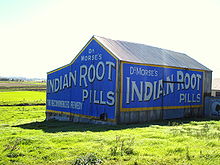- Dr. Morse's Indian Root Pills
-
Dr. Morse's Indian Root Pills was one of the most successful and enduring products to be manufactured and marketed in North America as part of the lucrative patent medicine industry, which thrived during most of the 19th and 20th centuries. Its manufacturer claimed the pills contained herbal ingredients that would help "cleanse the blood," as "impurity of the blood" was believed to be the cause of all disease.
History
Dr. Morse's Indian Root Pills have their genesis in William Henry Comstock's father, Edwin P. Comstock, who founded a drug company in New York City in 1833. The Comstock patent medicine business was involved in the sale of a number of successful drugs, including Carlton's Pile Liniment, Oldridge's Balm of Columbia, Kline's Tooth Ache Drops and Judson's Worm Tea. Between 1833 and the time of the acquisition of the rights to Dr. Morse's Indian Root Pills, the company remained under the control of the Comstocks through the additional involvement of Edwin's brothers; Lucius, Albert Lee, John Carlton and George Wells.
The Indian Root Pills were first formulated and manufactured in 1854 by Andrew B. Moore, who was then operating under the name A.B. Moore in Buffalo, New York. Rights to the pills were then transferred through a number of different business partnerships under the control of Moore, Andrew J. White, Baldwin L. Judson, George Wells Comstock and his nephew, William Henry Comstock. These reorganizations all occurred amid numerous disputes and lawsuits. During that long period of instability, the manufacturing operations moved from Buffalo to New York City and then to dual sites on opposite sides of the St. Lawrence River, one at Brockville, Ontario and the other at Morristown, New York. Ownership of Dr. Morse's Indian Root Pills finally stabilized in 1867 when it settled solely in the hands of William Henry Comstock, and thereafter business was carried out under the name W.H. Comstock Co. Ltd.
When William Henry Comstock died in 1919, control of the company passed to his son, William Henry Comstock II, known as "Young Bill." William Henry Comstock II died in 1960, and W.H. Comstock Co. Ltd. ceased operations a year later, patent medicines having already been in decline.
Bibliography
Shaw, Robert B. History of the Comstock Patent Medicine Business and Dr. Morse's Indian Root Pills. Washington: Smithsonian Institution Press, 1972.
External links
- Project Gutenberg: History of the Comstock Patent Medicine Business and Dr. Morse's Indian Root Pills by Robert B. Shaw
- 'Restored in 2000 by Letterheads' Advertisement for Dr Morse's Indian Root Pills on an old shed outside Morpeth, NSW, Australia. Research and Restoration Project Team Leaders... David Beattie, Gail Beattie, Michael George.
Categories:- Patent medicines
Wikimedia Foundation. 2010.


